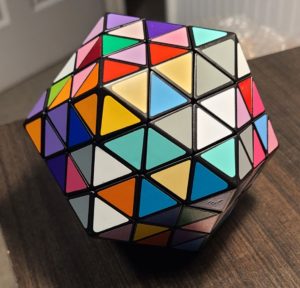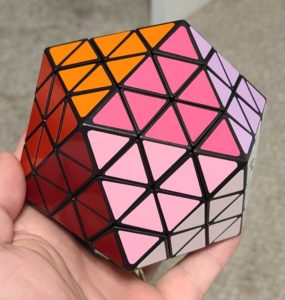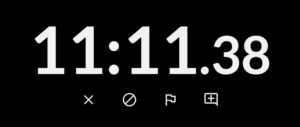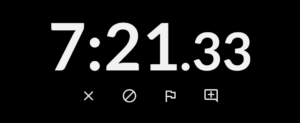 As stated previously, I’m loving my new magnetic Megaminx and this morning, a quiet Saturday with a sleeping puppy by my feet, I figured I’d do a quick speedrun. It was about 1:10 before I got my first two layers done – mostly par for the course – but my middle edges/corner matching was pretty solid. This puzzle’s bright faces make it easy to identify and so for the first time, I’ve been looking ahead. A quick slip-up on my penultimate layer and some fidgeting permuting centers (my weakest step) made things a bit slow, but I’ve become much more adept at orienting corners and placing them. The end result? A staggering one-minute improvement and a mind-boggling 4:16 solve! I was blown away!
As stated previously, I’m loving my new magnetic Megaminx and this morning, a quiet Saturday with a sleeping puppy by my feet, I figured I’d do a quick speedrun. It was about 1:10 before I got my first two layers done – mostly par for the course – but my middle edges/corner matching was pretty solid. This puzzle’s bright faces make it easy to identify and so for the first time, I’ve been looking ahead. A quick slip-up on my penultimate layer and some fidgeting permuting centers (my weakest step) made things a bit slow, but I’ve become much more adept at orienting corners and placing them. The end result? A staggering one-minute improvement and a mind-boggling 4:16 solve! I was blown away!
Archive for the Cubing Category
Another New Megaminx Record! WOW!
Posted in Best / Worst, Blog, Cubing, Cubing Records on July 2, 2022 by slatemanNew Megaminx Record!
Posted in Best / Worst, Blog, Cubing, Cubing Records on July 1, 2022 by slateman I was really impressed with my latest Megaminx record – getting my time down to 7:21 and then an even 6:00. In light of having this kick-ass new Gan 3×3, I realized just how good a magnetic speed cube can be. Next up really should be a 2×2 or a Pyraminx, but neither are really FUN puzzles. The Megaminx, however, it an entertaining solve and with that, my order was set: YJ YuHu V2M. I lubed it up and immediately noticed just how fast and precise it was. One sub-seven-minute solve (would’ve been my record just a few months ago) was followed by a slamming sub-5:30! I was impressed by just how good this puzzle was! One more sub-6 and then I got a 5:18! FORTY seconds faster than my old record!
I was really impressed with my latest Megaminx record – getting my time down to 7:21 and then an even 6:00. In light of having this kick-ass new Gan 3×3, I realized just how good a magnetic speed cube can be. Next up really should be a 2×2 or a Pyraminx, but neither are really FUN puzzles. The Megaminx, however, it an entertaining solve and with that, my order was set: YJ YuHu V2M. I lubed it up and immediately noticed just how fast and precise it was. One sub-seven-minute solve (would’ve been my record just a few months ago) was followed by a slamming sub-5:30! I was impressed by just how good this puzzle was! One more sub-6 and then I got a 5:18! FORTY seconds faster than my old record!
That evening, I revisited the puzzle, getting several close times (in the 5:20 – 5:30 range). Whether a sub-five-minute solve is possible, I’m not sure, but this puzzle is simply wonderful and it’s still just so much fun revisiting things like this and breaking records. Of course, I’m probably getting close to my limits on them all, but at 46 years old, I’m still enjoying it! So psyched!
THREE New Cubing Records: May 2022!
Posted in Best / Worst, Blog, Cubing, Cubing Records on June 24, 2022 by slateman
The end of the school year, covid, surgeries and home renovations delayed this post, but it’s an exciting one, if I might say so myself. Moving backwards, in late April a student in my Spanish 2 class (one with a PB of around 17 seconds) brought in her Gan 3×3. Over the past 11 years of cubing, I’ve regularly updated my main – maybe once every other year or so, but my record has stood since barely dropping a half a second from it in May of 2018. This new puzzle was unlike any other I’d tried before. The magnets were snappy, turns felt super responsive and it glided like butter. I was on a mission.
Upon purchasing a Gan 356M, their middle-of-the-line budget model, I realized it was just way too loose. I should’ve opted for the model with extra GES nuts to help with tension, but I already felt badly spending $30 on another 3×3!!! When I got the cube finally tensioned how I wanted it, I couldn’t believe just how wonderfully it turned. This is the best puzzle I’ve ever owned. To put things in perspective, I had accomplished three sub-30 second times in my prior decade of cubing. I accomplished the feat six times in a week with my Gan 356. My first, an astonishing 28.6 seconds shaved almost half a second off my time. I was elated. I saw it coming. My record broken – for the fourth time in a row in the month of May!
However, that wasn’t all. Two days later, I utterly shattered my record, trimming two full seconds off! The solve was magical. Three of the four cross whites already done so I could start planning my corners ahead, something I NEVER can do. Three middle layers were super fast and I could see ahead as I placed those pieces swiftly. On the top layer, I had an L and then had to swap two corners. This left me with a fully-solved yellow face. A quick three-cycle solved the puzzle in the fastest time EVER! 26.46 seconds! While I was at it, I broke all my average records: Averages of 3/5/12/50/100 all were decimated, with my average-of-3 being sub-30!
Unfortunately, future solves revealed that without a very lucky skip, I will never match or best that time. If I can’t get the second layer done by 15-17 seconds, it’s not even worth finishing. Once you hit that stage, a lot of the fun is sucked out of speedsolving. I’ve dabbled in F2L, but without memorizing all new algorithms, I don’t see it ever happening. With my 4×4 and 5×5 records at incredible times and with good cubes alongside of them, I genuinely wonder if my days of timing myself are over.
But then I wondered if I could give the Megaminx another swing. Upon getting a new puzzle for Christmas (which itself resulted in breaking a decade-old record), I figured why not try again? Solve #1 was close to the 7:21 record from January and solve #2 was…just remarkable! 6:00.77! I trimmed my record by 80 seconds!!! I got a lucky last layer and just missed a sub-6 by three-quarters of a second!
I’m happy these old bones still have some speed in them. Three records in one month – not bad for a 46-year-old!!!
Master Icosamate Algorithms
Posted in Algorithms, Blog, Cubing on May 8, 2022 by slatemanThis puzzle is kicking my ass. Fortunately, our hero Super Antonio Vivaldi made a tutorial (including another video with algorithms and another on the regular Icosamate.)
Step One: Get Corners On One Face
This should be done intuitively. Use a beginner’s method to move/rotate these as you go on.
Step Two: Permute Last-Layer Corners
This is a challenge and will be the most time-consuming part of your solve. First, flip the puzzle over and remember your bottom-layer colors (it’s easy to get mixed up and forget, particularly after putting the puzzle down!) Now, you’re going to find one corner to use as a basis for figuring out what the top piece must be.
You will do a DDUU algorithm as expected. This swaps the top with the front center piece and it also swaps the back left and back right. Doing the algorithm a second time returns all to their proper spots. However, it will also rotate them.
Starting on the left side, this will spin those centers clockwise. Counter-clockwise is done starting on the right.
Usually you won’t have this all land perfectly. Remember some cheats: you can move up the front L & R pieces to the back L & R. Since those back ones will swap/rotate and the front won’t, it’s an easy way to move around which pieces you want.
If you’re stuck with a pair of adjacent ones, do the algorithm once. This swaps the top and the center. Then rotate the second wrong piece to the front and do the alg again. This is how you do a three-cycle. Make sure you do the DDUU on the right to start and then return with the left to ensure the back sides don’t get messed up.
Step Three: Rotate Last-Layer Corners
Get the top center rotated properly while keeping at least one corner oriented properly. You’ll do your DDUU until the top center is right (and you keep one aligned perfectly so you know which is which).
Now you’re going to get the remaining corners. You can have two or three out – never one. This is a beginner’s method approach using R’/D’/R/D. You’ll count how many turns you need. You will be looking for a multiple of five (to keep your top oriented correctly). You do your R’/D’/R/D until one corner is set. Then, using a last-layer method from a 3×3, keep the lower-right piece in place (it’s rotated wrong now). Keep doing the algorithm a total of five times (or multiple of five). If it’s not a multiple of five, that’s OK, now use the one incorrectly-rotated center as your center.
If you’re unlucky and get parity, you’ll find yourself with everything done and an incorrectly-oriented top center as stated above. In order to fix this, place your top center how it’s supposed to be. This will mess with the other five corners. *sigh*. Yup. Now using intuition, move around these pieces to get the top layer perfect.
I’m guessing here, but you’ll likely swap a top and a front – then turn the puzzle and perform the opposite algorithm (starting on left vs right). You’ll likely need to fix the piece you just put in place. Feel free to do so (clockwise or ccw).
If you get all those pieces put in properly, you’ll likely have a few corners which need rotations. Count how many you need: hopefully you’ll end up with five rotations and go back to the R’/D’/R/D to figure it all out.
Step Four: Match Edges
This three-cycle will swap edges. This will go red/green/blue clockwise if you start on the right. Like the Face Turning Octahedron algorithm, this will require you to bring one slice down, then do a D/D/U – return slice – D/U/U algorithm.
Starting on the left will rotate them clockwise (R/G/B). You will use a face with a V in front of you (like the blue/green shown here). If you bring the left (red) piece down, then you do Right down, left down, right up – return slice – right down, left up, right up.
If you start on the right (move yellow down to the blue), then your algorithm will go left down, right down, left up – return slice – left down, right up, left up.
Now…what to do when a pair are inevitably flipped upside down? OK, so get them adjacent like you’ve been doing. You’ll be flipping these, so hopefully these are your last two edges that need fixing. If they’re the blue and green here, use a dummy piece (yellow) as a start. Now, you’re going to want to flip the green piece. Do this by the following:
You’re going to be working with the lower-right corner (LR – the green triangle) and bottom layer. Turn LR’, then D, D, and return LR LR. This will flip the piece that was originally there.
Now, do your algorithm. Then undo your flip, now by LR’, LR’ D’, D’ and LR – the opposite of your prior flipping alg. Finally, do your step-four algorithm two more times. If you need guidance, check out SAV’s tutorial (with timestamp).
Step Five: Match Petals
This algorithm is the opposite of the step-four alg. Here, however, you will move up the M slice layer, perform three moves, return the M slice and then do three more. It’s almost exactly the opposite of the one above. I need time to get to this part.
Start by moving that M slice up to put the pink petal where the yellow is. Then, using the colored center as your basis, do a Right down (x2), left down (x2), right up (x2) then restore the M slice to its original spot and do a Right down (x2), left up (x2), right up (x2).
Update: A solid week of dedicated work resulted in a full solve. One of my proudest solves. Not sure how eager I am to mix this up again. :D
Rex Cube/Super Ivy Cube Algorithms
Posted in Algorithms, Blog, Cubing on May 7, 2022 by slatemanI bought a Rex Cube ages ago but never really enjoyed solving it. The puzzle itself felt like it was going to fall apart at any minute and upon solving it, I shelved it and hardly ever touched it again.
Last year I purchased a Super Ivy Cube and despite being the exact same puzzle in a sense, it’s a lot more fun and a much more solid. However, as usual, I forgot the final step and had to look it up. Thus, the usual tutorial/algorithms for my own personal reference.
Step One: Align All Edges
This is an intuitive step and is essentially solving a Dino Cube. You should be able to get all of these solved pretty easily.
Step Two: Move Centers
This is the standard up/up/down/down algorithm and I do this intuitively as well. I try to get three mismatched centers oriented around one corner to easily swap them. If they’re all in a line, I just try to solve one before moving on.
Step Three: Move Petals Around
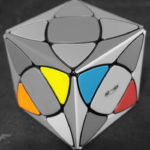
This algorithm is the only reason for this post, really. This will swap petals on your front faces as seen here. You will start with Right up, left up, right down, left down, then turn the puzzle clockwise on the corner you’re looking at and reverse it. Left up, right up, left down, right down. This should flip those two sets of petals. Now, it’s just a matter of coordinating those swaps and you’re gold!
New 6×6 & Megaminx Records!
Posted in Best / Worst, Blog, Cubing, Cubing Records on January 3, 2022 by slatemanI started cubing almost 11 years ago and in my early days, I was more focused on speed than I am now. However, while my collection is now more focused on diversity and uniqueness – I still like to dabble into speedsolving from time to time. With a new, Christmas boost to the collection – I’ve upgraded my 6×6 and Megaminx – the former, a terrible V-Cube and the latter broken in shipping. Due to these substatial updates, new efforts were made to break decade-old records and in each case, the personal bests fell swiftly.
My 6×6 record, residing at over 15 minutes, was shorn to 11:11: an improvement by over four minutes. The Megaminx took a pair of tries before it too tumbled. I only did this puzzle for speed a few times, and I don’t endeavor to break this record – a half-minute improvement – any time soon.
A pair of records brought into the current decade, now leaving but the 2×2 and Pyraminx as sole representatives of the 2010s. Oh, and the 3×3 but that’s OK. My full cubing records can be found here.
4x4x6 Algorithms
Posted in Algorithms, Blog, Cubing on July 30, 2021 by slatemanThis was my favorite puzzle and when it fell and got destroyed in Sweden, I was heartbroken. However, a few years later, whilst living in Italy, I replaced it and – to my dismay – realized I had forgotten some crucial steps into solving it!
Things are really quite simple and matching those inner-edge pieces remains my toughest challenge. I figure I should catalogue this stuff for future reference, rather than relying on old YouTube videos to help me through. OK, let’s see!
- Solve centers (like a 4×4)
- Solve edges (like a 4×4)
- Return to Cuboid (like a 3×3)
- Make sure your two middle layers are all perfect
- Solve inner-edge pieces (I struggle here)
- Position inner-lower layer ‘cross’ segment (LL is not necessary yet)
- Then solve inner-lower layer edges (like a 3x3x2): R2 / U / R2 / U’ / R2
- Now inner-upper layer edges (headlights)
- Headlights on Left (or do this 2x): R2 / U / R2 / U’ / R2 — u’ / d — R2 / U’ / R2 / U / R2
- Inner-edge swap (Opposite): R2 / U2 / R2 / U2 / R2
- Inner-edge swap (Adjacent): R2 / U / R2 / U — R2 / U2 / R2 / U2 — R2 / U / R2 / U’ / R2
- Middle-Layer Parity (If necessary): Uu2 / R2 / F2 (Uu2 / U2) F2 / R2 / Uu2 / F2
- Now bottom cross (intuitive)
- Bottom edges (just like step #7)
- Repeat Headlights & inner edges steps (#8)
- Middle-Layer Parity Redux (if necessary)
See if that makes sense the next time I need it!!!
Update 2023: Fixed for clarity and remedied errors – this puzzle is still my favorite!
New 4×4 Record: 1:43.62!!!
Posted in Blog, Cubing, High Scores/Accomplishments on April 2, 2021 by slateman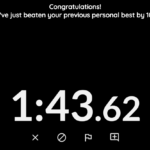 When I broke my four-year-old 4×4 record last month, I was rather thrilled, securing my first sub-2-minute solve in the process. I was quite content with the accomplishment and immediately felt satisfaction and zero motivation to improve upon the time. However, as I’m on spring break right now, I’ve been tinkering around with the puzzle and it’s so spectacular! The magnets are just wonderful and as I was running through things, I noticed two things. First, my centers are done in about 20 seconds. Second, I’ve been getting better at edge matching. First, I match white edges and then move on to yellow. These high-contrast pieces are much easier to keep track of and instead of lining up several edges at once (like the pros do), I just wing one at a time and keep track of other edges which is actually more productive.
When I broke my four-year-old 4×4 record last month, I was rather thrilled, securing my first sub-2-minute solve in the process. I was quite content with the accomplishment and immediately felt satisfaction and zero motivation to improve upon the time. However, as I’m on spring break right now, I’ve been tinkering around with the puzzle and it’s so spectacular! The magnets are just wonderful and as I was running through things, I noticed two things. First, my centers are done in about 20 seconds. Second, I’ve been getting better at edge matching. First, I match white edges and then move on to yellow. These high-contrast pieces are much easier to keep track of and instead of lining up several edges at once (like the pros do), I just wing one at a time and keep track of other edges which is actually more productive.
Anyhow, as I have noticed an improvement, I figured I go for time. My best average-of-five now resides around 2:07 with a new record a full 10 seconds faster than my prior record! Pretty damn cool, I have to be honest. I can’t see any huge change coming in the future, but I may keep trying. \m/
Following Day Update: I haven’t come close to my 103-second solve, but it was not for a lack of effort. In the process, I managed a 2:05.28 average-of-five. it’s hardly disappointing: 2:05 would’ve been my personal best before last month!
New 5×5 Record! Sub-5 Minutes!
Posted in Best / Worst, Blog, Cubing, High Scores/Accomplishments on March 25, 2021 by slateman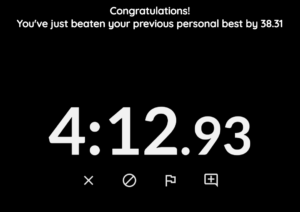 I haven’t really tried for a 5×5 record in ages. I purchased my ShengShou way back in 2012 and promptly broke my record. However, while the puzzle itself is pretty good, I only rarely returned to try to break my just-over-five-minutes standard.
I haven’t really tried for a 5×5 record in ages. I purchased my ShengShou way back in 2012 and promptly broke my record. However, while the puzzle itself is pretty good, I only rarely returned to try to break my just-over-five-minutes standard.
For Christmas, I made a massive order of puzzles. I got like a dozen or something and among them were three magnetic puzzles: a 3×3, 4×4 and 5×5. Now, I’ve already proclaimed my love for these last month when I broke my four-year-old 4×4 record getting my very-first sub-two-minute solve. Today, with some extra time on my hands, I figured I’d take a stab at the 5×5, a puzzle I haven’t improved time on in eight-and-a-half years.
The stickerless, magnetic ShengShou is a great puzzle. It never locks up, those magnets help tidy up those quick turns and it cuts like a dream, so I’m rarely ever stuck between layers. My first solve was almost 5:30 – not too bad with no practice and my second was 5:07, a mere five seconds off my record. Solve #3 was it: my first sub-five-minute 5×5! Clocking in at 4:51, I beat my old record by 11 seconds!
After a mess up and another 5:something time, the stars aligned and…OMFG??!! 4:12.93! That is fifty seconds better than the record which stood since October of 2012. FIFTY SECONDS! I don’t even know what to say! Beating this would require some serious dedication but, like the 4×4 before it, I’ve accomplished what I’ve always wanted to: a sub-five. The four-minute finish line feels way too far off. I think next up will be a new 6×6. Still rocking the V-Cube 6 I bought in August of 2011. Urgh.

